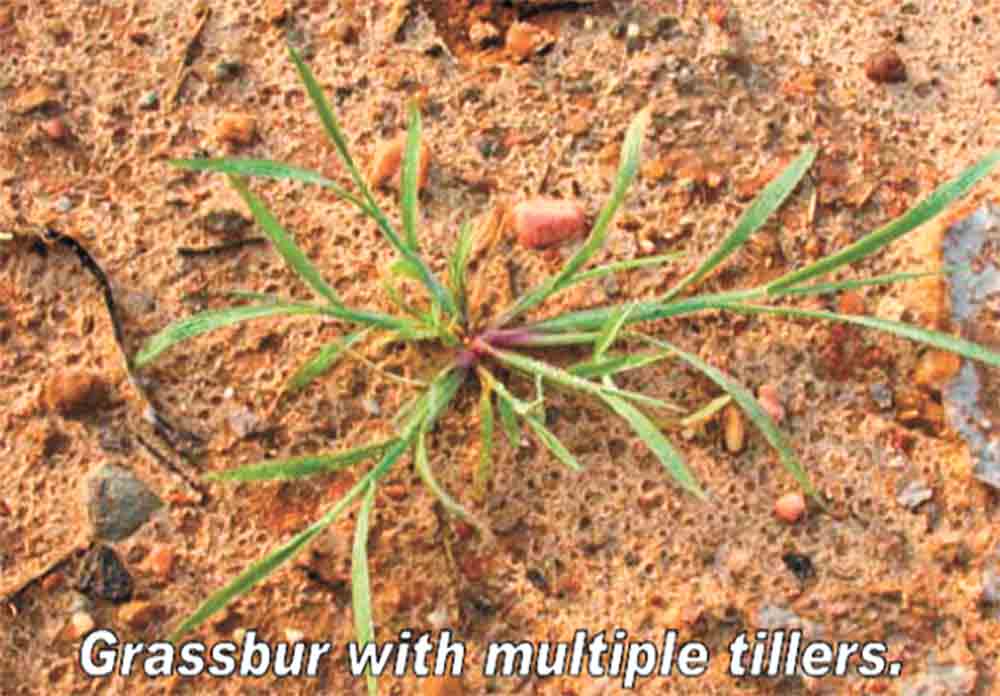
By Matthew R. March, MNRD
Polk County Extension Agent
Grassburs in turfgrass and pastures have been a hot topic this fall at the extension office. These pesky almost painful seed pods are a nuisance in turfgrass and cause economic damage in pastures and hay fields. While grassburs, or sandburs as they are also known, can be present every year, this year there was a bumper crop in Polk County. This is likely a result of dry hot conditions throughout summer that caused desirable grasses to decrease in growth allowing grassburs to move in.
Texas is home to approximately five species of grassburs belonging to a group of grasses called Cenchrus. While some species of grassburs are perennial, the most abundant and widespread species throughout Texas and Polk County are an annual called common sandbur, or Cenchrus spinifex. Common sandbur germinates in late spring and will continue to germinate and grow throughout the summer months. The grass does not become a problem until the plant produces the spiny seedpod in late summer and throughout the fall. While common sandbur will die off after the first frost, you can guarantee it will be back next year and the rest of this article will focus on controlling grassburs in turfgrass and in hay fields/pastures.
Grassburs are generally not a problem in well-maintained turfgrass by following proper cultural practices such as applying the right amount and type of fertilizer, mowing at the correct height, and proper irrigation. Grassburs thrive in nutrient deficient soils and taking a soil sample and following the recommendations from the results can correct nutrient deficiency. Irrigation can be tricky as overwatering causes poor root development that can allow grassburs to take over if conditions become dry. Also, lack of irrigation during the summertime will decrease turfgrass vigor allowing grassburs to move in.
Another effective cultural practice is to mow your lawn with a mower that catches the clippings. Remember, common sandbur is an annual so by removing seeds you help to reduce the number of seeds in the soil available to germinate next year. Pre-emergent herbicides are the most effective chemical control method. Pre-emergent herbicides containing active ingredients Dithiopyr, Indaziflam, Oryzalin or Pendimethalin are most effective. Apply when soil temperature is between 52 and 72 degrees in the spring. Depending on the product, a second application may be needed several weeks later. Most post-emergent herbicides effective against grassburs are only available to professional landscapers with Image Kills Nutsedge the only practical post-emergent option for homeowners.
Grassbur control in hayfields and pastures is achieved through early recognition. Young grassbur plants do make fair forage when young, but should be treated with herbicide as soon as they are identified. The leaves on young plants are usually hairless, but the sheaths will contain hairs as the plant matures. A membranous ligule is present with hairs on the fringe. Stems are usually flattened and will be purplish in color. Often you can dig up seedling grassburs and still find the grassbur attached to the root. Scouting should occur regularly throughout the spring and summer. Timely application of post-emergent herbicides is critical for control and makes regular scouting critical. Pastora is recommended for post-emergent control in Bermuda grass but will kill bahia grass. If you have had grassbur problems in previous years, you may want to consider applying the following pre-emergent herbicides. Prowl H20 in winter dormant Bermuda grass only or Rezilon in Bermuda grass and bahia grass.
Grassburs can be a thorn in your side, literally! But following proper cultural practices and applying herbicides when needed can help reduce the number of grassburs in your lawn or cow pasture.
You are a guest
or post as a guest
Be the first to comment.

